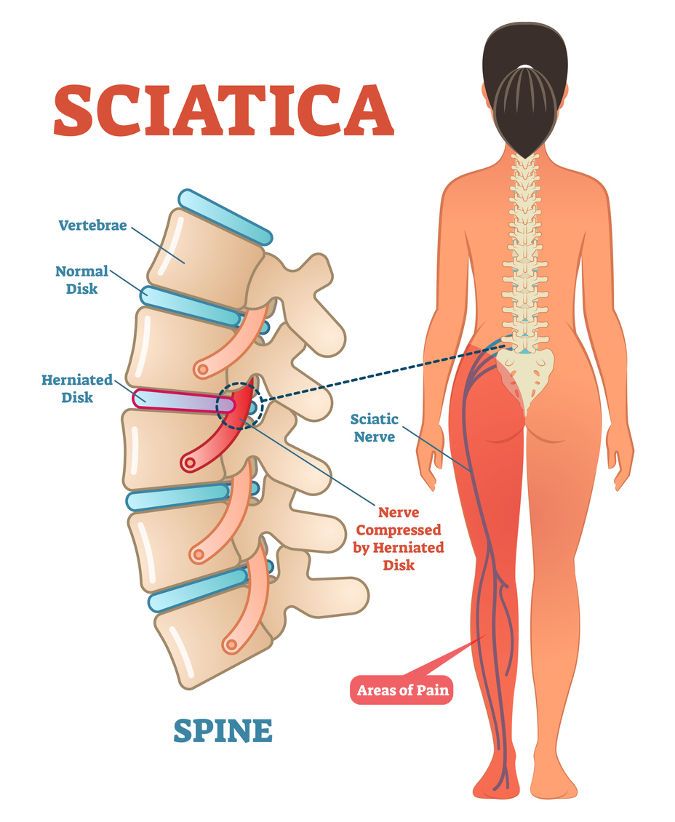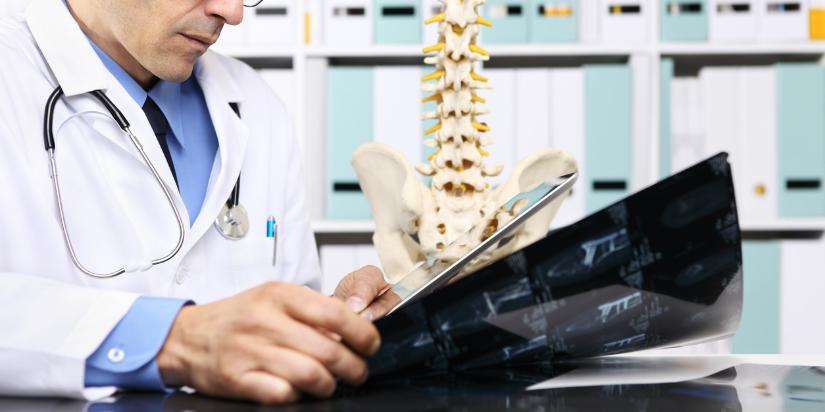The symptoms of sciatica or peripheral neuropathy are easy to confuse. Both conditions cause pain, numbness and tingling in the legs and feet. The impact on your strength and balance may also make falls more likely.
Sciatica and peripheral neuropathy are two of the more challenging conditions treated at Algonquin Chiropractic Center. Both will have a profoundly negative impact on your lifestyle and simple activities like getting up in the morning, rolling in bed, sitting, bending, lifting, walking and shopping. All will be difficult if not impossible.
Many with these conditions find it impossible to sleep! Being in pain is one problem, but being exhausted and in pain is even worse.
The conditions are very different, however. Read on to learn more and find out how chiropractic care can help.
What Is Sciatica?
Unlike a conventional “disease,” sciatica is nothing more than a common set of symptoms, so doctors can’t “diagnose” anybody with it, but they can determine and correct the underlying cause.
Many patients are from the ages of 35 through 55, but pediatric and geriatric patients can experience sciatica, too. In part, sciatica owes its prevalence to its many causes. Everything from the immediate trauma of a car accident or fall to subtler, long-term causes that result in disc herniation can be responsible for a patient’s sciatica.
What Are Symptoms of Sciatica?
The primary symptom of sciatica is persistent pain or numbness in the low back, glutes or hips that radiates down the leg into the feet and toes, though symptoms can manifest anywhere along the sciatic nerve. In fact, exceptionally high pressure on the sciatic nerve will cause foot and leg weakness, as well. Ultimately, patients may not experience sciatica in exactly the same place.
The key is not to confuse sciatica with peripheral neuropathy. The most important difference between the two is that peripheral neuropathy is static, while sciatica’s symptoms can flare up or dissipate depending on certain levels of physical activity. If your symptoms worsen when you rise from bed in the morning, sit down, bend over, roll over or even cough, then you likely have sciatica rather than peripheral neuropathy.
How to Alleviate Symptoms of Sciatica
As the world’s leading cause of opioid addiction, low back pain and disability, sciatica is a serious back injury that’s responsible for thousands of back surgeries each year. So, get conservative, professional help now!
Once you recognize that you have sciatica, there are many ways for you to alleviate symptoms, including icing, topical analgesics, light exercises, gentle stretches and strategic body positioning. If you don’t have any clue what these exercises, stretches and positions might be, have no fear! Algonquin Chiropractic Center can help you stick to a plan that caters to your specific symptoms.
What Is Peripheral Neuropathy?
There are over 100 different types of neuropathy, but here are the three major types:
- Sensory Nerves – These receive signals such as pain, temperature and vibration.
- Motor Nerves – These are responsible for muscle movement.
- Autonomic Nerves – These maintain passive functions like digestion and heart rate.
We’re going to focus on sensory peripheral neuropathies.
Peripheral neuropathy is the degeneration or damage of the nerves in the peripheral nervous system, which encompasses all nerves outside the brain and spinal cord.
Most commonly, neuropathy symptoms begin in the toes and feet, gradually moving up the leg as the condition worsens. Next, neuropathy may develop in the fingers and hands, always starting in the smallest nerves furthest from the spinal cord.
For each of these three types of nerves within the peripheral nervous system, peripheral neuropathy develops when a nerve’s “axons and myelin sheaths” take damage. All you need to know about these axons and myelin sheaths is that they send signals to the brain.
The axon is like a copper wire, and the myelin sheath is like the wire’s coating. If the coating comes off, the axon can be damaged. You’ve probably heard of “demyelinating diseases,” the most common of which is multiple sclerosis.
Damaged axons and myelin sheaths either don’t send signals or send incorrect signals.
What Are Symptoms of Peripheral Neuropathy?
Patients tend to experience symptoms in the hands and feet. There are many causes of peripheral neuropathy, though the most common are diabetes, chemotherapy, long-term steroid use and alcoholism. Some causes may even be “idiopathic,” which means that the cause is unclear.
Complications of neuropathy include loss of life enjoyment, difficulty walking or standing, poor balance that increases fall risk, difficulty sleeping, poor wound healing, ulcers, gangrene and amputation. The loss of circulation and sensation can yield any of these outcomes.
How to Alleviate Symptoms of Peripheral Neuropathy
As with most conditions, prevention is the best treatment. If you have had diabetes, a history of prolonged steroid use, a history of alcoholism or chemotherapy, you have to be more aware. Can you feel the cold tile when you walk into the bathroom each morning? Does the hot shower not feel as hot on your feet? Have you lost your balance recently? Early treatment is best.
The Symptoms of Sciatica Depend on Circumstances
As sciatica is a common set of symptoms, the severity of these symptoms depends on a few different factors.
For example, pain and numbness with sciatica are usually worse in the morning. You’re also likely to feel worse when sitting or driving. Coughing or sneezing adds also to the pain for some people.
Location of Symptoms
In most cases, the pain and numbness associated with sciatica will start in the lower back. Next, symptoms radiate to the hip and travel down the leg to the foot in a predictable pattern. Your symptoms are usually confined to one side of the body.
Symptoms range from mild to severe.

Causes and Related Problems
Nerve irritation or compression in the lower back most often cause sciatica. Back pain is also common. Two other problems, herniated disc and spinal stenosis, may also play a role.
Doctors may order MRIs or EMGs to learn more. They may also recommend addictive medication, physical therapy, steroid injections or surgery.
The Symptoms of Peripheral Neuropathy Primarily Affect the Legs and Feet
Peripheral neuropathy differs from sciatica in many ways. For example, its symptoms do not vary by the time of day. Sitting, coughing, or sneezing are not likely to affect the symptoms either.
You are also not likely to have back pain, a herniated disc or spinal stenosis.
Location of Symptoms
Symptoms usually start in the toes and feet and slowly travel up the leg. Unlike with sciatica, symptoms most often affect both sides of the body.
Symptoms can range from mild to severe.
Causes and Related Symptoms
Peripheral neuropathy usually occurs when poor circulation leads to nerve degeneration. The lack of circulation causes problems in the legs, feet and toes.
Doctors may order an EMG and prescribe medicine. They may also tell you there’s nothing more they can do.
So, what do we do?
Chiropractic care can help, even if other treatments have failed. Algonquin Chiropractic Center, in Algonquin, IL, has treated thousands of patients from the Chicago area.

How We Treat Sciatica
First, we perform a thorough history exam and order proper imaging. The exam will make it clear whether you have sciatica or peripheral neuropathy.
Many patients come to us as a last resort. As a result, they have had imaging done before. If needed, however, we will X-ray sciatica patients.
We do not routinely order MRIs. Research suggests an MRI should be ordered only in certain cases. These include weakness, progressive neurologic deficit, or cauda equina syndrome. MRIs are also ordered if you haven’t improved 50% in the first 2 to 4 weeks of treatment. Most sciatica patients do not need an MRI.
If we can help you, we will tailor a program to your needs. This may include:
- Cox Technic – A gentle decompressive treatment that creates negative pressure on the disc and nerve.
- Manipulation – Not used in the early treatment of sciatica, but may be used in the chronic phase.
- Interferential current – A soothing electrical stimulation wave to control pain.
- Super Pulsed Laser – Penetrates deeply into the soft tissues to speed up healing and increase circulation.
- Standing Vibration Therapy – Vibration therapy improves posture, increases core strength, and improves balance 3 to 4 times faster than standing on the ground. You won’t find this therapy in most rehab centers.
- Custom-Made Orthotics – The alignment of your feet will affect your posture. This may add stress on your lower back. Custom-made orthotics put the feet in better alignment. Orthotics help level the pelvis, improve posture, and decrease shock stress.
- Massage therapy – Not your “traditional massage.” Our therapists break up adhesions and scar tissue, improve flexibility, and “movement patterns.” Massage also enhances posture.
- Rehabilitation – Initially, exercises are given to decrease pain and inflammation. We then gradually add in core exercises and progress to full-body exercises.
How We Treat Peripheral Neuropathy
Again, most people have been to their medical doctor already, and even to a neurologist.
Depending on your care, you may be uncertain at this point whether you have sciatica or peripheral neuropathy or another condition.
Some patients have been given an EMG or a nerve test. Some have been told nothing can be done. Many have tried various medications with varying degrees of success, but all have unwanted side effects.
Peripheral neuropathy patients come to us for an alternative to strong drugs with side effects. They are looking to get to the cause of the problem and not cover it up with meds.
To do that we may use one or more of the following:
- Super pulsed laser – This type of laser produces nitric oxide, which boosts circulation, increasing blood flow to heal the nerves.
- Seated vibration – Patients sit with their feet on a vibrating platform. The vibration increases blood flow to the feet and toes.
- Standing vibration – This treatment improves circulation and balance.
- Rebuilder therapy – Patients wear a “conductive garment” that looks like a sock. The garment conducts specialized electrical signals over the feet and toes, helping heal damaged nerve endings.
- Massage – Massage increases circulation and blood flow to the feet and toes.
- Custom-made orthotics – Orthotics help relieve pain in the feet while improving balance.
- Diet and nutrition – Eating better decreases inflammation, controls blood sugar, increases circulation and heals nerve tissue.
The same treatments may be used for sciatica and peripheral neuropathy in some cases. Reasons for the treatments are not the same, however. The desired effects on the body depend on the condition.
Chiropractic Care Helps Sciatica or Peripheral Neuropathy
Without proper treatment, these conditions can get worse, threatening your quality of life. You may reach a point where you will try anything and end up having invasive procedures that often don’t eliminate the problem. Even worse, you may become addicted to opioid pain medicine to find some relief.
Algonquin Chiropractic Center has helped hundreds of people with sciatica or peripheral neuropathy in Algonquin. We can help you get back to your active lifestyle. No drugs, injections or surgery are necessary.
Put an end to the pain by calling (847) 854-2000 for an appointment. Learn how Algonquin Chiropractic Center in Algonquin, IL, can change your life for the better.
Editor’s Note: This blog was originally published in January 2018 and updated in May 2023.



